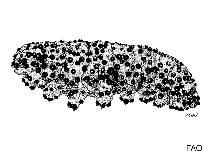Isostichopus badionotus (Selenka, 1867)
Chocolate chip sea cucumber| Native range | All suitable habitat | Point map | Year 2050 |

|
| This map was computer-generated and has not yet been reviewed. |
| Isostichopus badionotus AquaMaps Data sources: GBIF OBIS |
Classification / Names Common names | Synonyms | CoL | ITIS | WoRMS
Holothuroidea | Synallactida | Stichopodidae
Environment: milieu / climate zone / depth range / distribution range Ecology
Benthic; depth range 0 - 65 m (Ref. 111335). Tropical
Distribution Countries | FAO areas | Ecosystems | Occurrences | Introductions
Western Atlantic: USA, throughout the Caribbean, south to Brazil.
Length at first maturity / Size / Weight / Age
Maturity: Lm ? range ? - ? cm Max length : 20.0 cm TL male/unsexed; (Ref. 86832)
Life cycle and mating behavior Maturity | Reproduction | Spawning | Eggs | Fecundity | Larvae
Members of the class Holothuroidea are gonochoric and have only one gonad. Spawning and fertilization are both external and some exhibit brooding. Life cycle: Embryos develop into planktotrophic larvae (auricularia) then into doliolaria (barrel-shaped stage) which later metamorphose into juvenile sea cucumbers.
Main reference
References | Coordinator | Collaborators
Collin, R., M.C. Díaz, J. Norenburg, R.M. Rocha, J.A. Sánchez, M. Schulze, A. Schwartz and A. Valdés. 2005. (Ref. 415)
IUCN Red List Status (Ref. 130435: Version 2024-1)
Least Concern (LC) ; Date assessed: 18 May 2010
CITES status (Ref. 108899)
Not Evaluated
CMS (Ref. 116361)
Not Evaluated
Threat to humans
Harmless
Human uses
| FishSource |
Tools
More information
Trophic Ecology
Food items
Diet
Food consumption
Ration
Predators
Diet
Food consumption
Ration
Predators
Ecology
Population dynamics
Life cycle
Distribution
Human Related
Aquaculture profile
Stamps, Coins Misc.
Stamps, Coins Misc.
Outreach
Taxonomy
References
Internet sources
BHL | BOLD Systems | CISTI | DiscoverLife | FAO(Publication : search) | Fishipedia | GenBank (genome, nucleotide) | GloBI | Gomexsi | Google Books | Google Scholar | Google | PubMed | Tree of Life | Wikipedia (Go, Search) | Zoological Record
Estimates based on models
Preferred temperature
(Ref. 115969): 22.8 - 28, mean 25.5 (based on 374 cells).
Resilience
(Ref. 69278):
High, minimum population doubling time less than 15 months (K=0.5).
Price category
(Ref. 80766):
Unknown.



